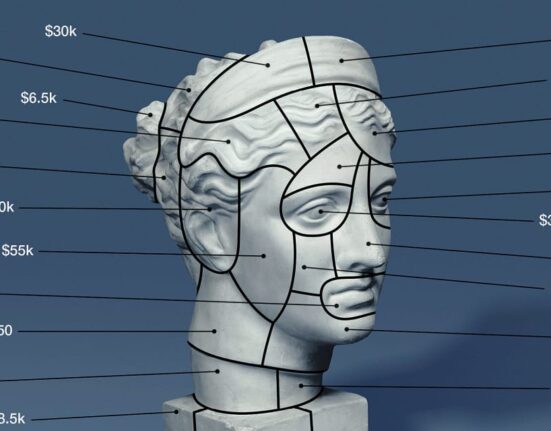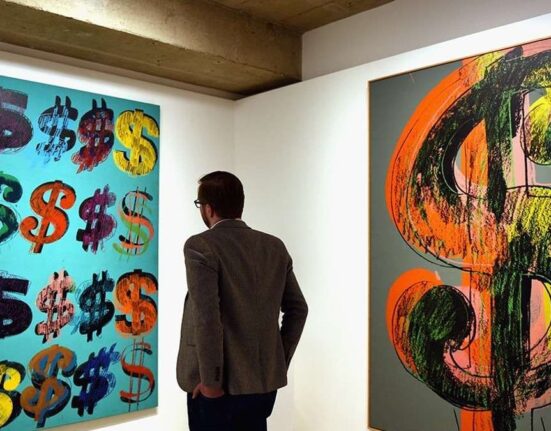Contemporary art outperformed other asset classes during the 2020 downturn and investors should seriously consider its ability to buck the trend in a pinch, writes Vedat Mizrahi, chief financial officer at Mintus.
The contemporary art market has performed extremely well over the last 40 years, outperforming the S&P500 Index by 240% since 1986. Over the years, it has ridden out bumps in the stock market and shown that it doesn’t follow the movements of other types of assets. Those who recognise the risk inherent in cryptocurrency volatility may see the value in the steady appreciation of art.
When even an investment strategy predicated on US treasury bonds is enough to bring down a bank, we can all recognise that threats to the global economy have increased dramatically in just a matter of weeks. As a result, many investors are now wondering how best to protect their portfolios from extreme uncertainty.
Previously expected interest rate rises to curb inflationary pressures may now be pared back in an effort to stem the growing tide triggered by SVB’s collapse. And, while Bitcoin often appears to benefit from such crises, its allure is usually short-lived. Would the cryptocurrency markets survive another FTX-type scandal?
The generally accepted rule for investors with varying risk profiles is the same: build a portfolio that can weather the volatility by being well-diversified. Some investors think that diversification is merely allocating funds to different asset classes. It is not as simple as that, however.
The idea behind diversification is to combine different asset classes with different risk profiles and low to negative correlation. A risk-off event negatively affects some investments but would have a positive impact on others, reducing the overall risk and drawdown of the whole portfolio. In 2023, investors are scratching their heads and asking what those positively impacted investments are.
Technology stocks are being routed, the main indices are suffering, fixed income is rapidly losing value and commodities continue to be affected by macro events. Even real estate stands on the brink. In this environment, fine art can be helpful in improving the risk-adjusted returns of a portfolio.
Art is no longer just admired for its aesthetic value but as an investment. Developments within the art market over the last decade have been followed almost as closely as those within the stock market. Indices tracking the performance of fine art have held up well in the recent economic slowdown with auction houses continuously reporting record prices. Art as an investment has an increasing demand coupled with a limited supply and the ability to survive economic downturns and generate above-inflation returns.
According to the Knight Frank Wealth Report 2023, 59% of UHNWIs are looking to invest in art this year and it is the most likely to attract the highest investment among the ‘passion’ assets. Indeed, Knight Frank’s Luxury Investment Index shows art was 2022’s top performer, rising by 29%. Deloitte’s Art & Finance Report 2021 reveals that global sales of art and antiques reached over $50.1bn (£41m, €47m) in 2020, where online sales accounted for a higher percentage than the mainstream retail categories.
Finding a good balance between risk and return is the aim of any investment strategy. Different studies show that there are benefits of allocating 15% to 20% of a portfolio to alternative asset classes. Once the domain of institutional and high-net-worth investors, alternative investments continue to grow in popularity and are making their way into the portfolios of retail investors.
Like any other investment, the rate of return for alternatives is not guaranteed and past performance is not an indicator of future performance. However, it is fair to say that an illiquidity premium is usually attached to the alternatives and hence, they have historically generated better returns than more liquid asset classes.
The illiquid nature of alternatives and especially the art market is one of the key risks in investing in these asset classes and as a result, their allocation in a portfolio should be determined carefully. Years ago, people purchased art only due to a personal interest or liking of an artist’s work. However, nowadays an increasing trend in art is solely from an investment perspective due to its unique characteristics as an asset class.
This year, we may well see art becoming an even more important part of an HNWIs investment portfolio.
This article was written for International Adviser by Vedat Mizrahi, chief financial officer at Mintus.







